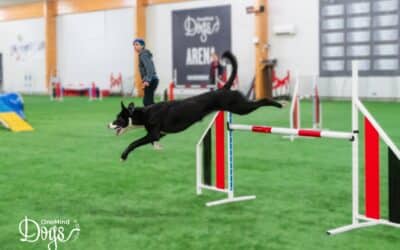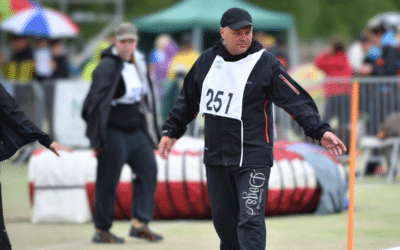In this article, we’ll look at how rewarding works, and how it allows us to communicate
effectively with our dogs. We’ll also share priceless tips and advice on how to improve
your rewarding skills, making your training sessions a lot more successful.
See things from your dog’s perspective
At OneMind Dogs, we teach humans how to speak their dog’s language. This requires
seeing things from your dog’s point of view.
Every dog is different when it comes to rewarding. Just like people like certain things
more than others (I like listening to music and going to the park with my dog), your dog
has its own preferences of what he finds rewarding.
You might think that a treat is the best reward for your dog, but do you know for sure?
This article will help you find out your dog’s favorite kind of reward.
Effective rewarding starts with the 5 W’s
When you’re thinking about rewarding your dog during training, it’s always good to keep
in mind the 5 W’s:
- Why do we want to reward?
- What do we reward with?
- Who are we rewarding and who’s doing the rewarding?
- When do we want to reward?
- Where do we want to reward?
Let’s go into these questions and what they mean for effective rewarding.
Why should we reward?
Is rewarding really necessary for dog training? Why do we want to reward our dogs? It
all comes down to the concept of positive reinforcement.
Rewarding is the best way of getting your dog to do something you want him to do. It
makes training a fun activity for him, not a chore that he has to get through. The right
kind of rewarding truly motivates your dog to do the right thing.
Without rewards, your dog will wonder what the point is. You’ll ask him to do something
and when he isn’t rewarded he thinks “Well that can’t have been that important”. On the
other hand, when you reward a certain behavior, he’ll remember to repeat that exact
behavior.
The more times we reward a dog for a certain behavior, the stronger that behavior will
become a natural response for them. It all comes down to making sure your dog is
having a great time during training.
What is a reward?
There are all kinds of rewards you can use when training your dog, including food, toys,
praise, or combinations of those things. Every dog has their own preferences on what
makes the perfect reward. Not sure what your dog likes to be rewarded with? Ask your
dog!
You can make a game out of having your dog choose his favorite reward. Lay out a
variety of things you know your dog loves on the ground, let your dog loose, and let him
take his pick. You might be surprised which one they choose!
Once you know what reward is the most fun and the most motivating for your dog, get
creative about how you can fit that reward into his training routine.
Lynn Madden, one of our expert instructors, has 3 dogs who love nothing more than
chasing the hose. After a training session, she lets them chase the hose and it’s the
best reward in the world for them. They work extra hard during training, knowing that a
reward is coming.
The myth about tugging
Many of our clients come to us worried, saying, “My dog’s agility coach says he needs
to be able to tug, but he doesn’t like it”. This is a big misconception in the agility training
world.
Remember, it’s all about seeing things from your dog’s perspective. If he doesn’t like
tugging, it’s not going to work as a reward.
The truth is, a dog doesn’t have to like tugging in order to become an absolute
champion in agility. Simply find what it is he likes the most, and use that as a reward
instead. You can do the same exercises with a different kind of toy, or a toy filled with
treats.
What are reward markers and cues?
Reward markers and cues are vitally important in rewarding, because they’re your way
of telling your dog, “Good job! Now you can get to have your reward”. So how do reward
markers and cues work?
It starts with getting clear on what you’re going to say to your dog when he does a good
job. You could say, “Get it!” “Catch It!” Or anything else you’d like. The most important
thing is that you be consistent with that phrase.
There are some great videos where you can see reward markers and cues being
used in our FREE webinar: “Rewarding Skills – The Secret of Fun and Effective
Dog Training”. You can watch the webinar HERE.
What is your dog’s playing style?
Training should be great fun for you and your dog, so it’s important to figure out your
dog’s playing style. That will give you insight into the kind of play you can use to reward
him.
The best way to find out your dog’s playing style is to watch him when he’s having fun
with other dogs. As an example, some dogs love to tug. When the other dog stops
tugging back, the fun’s over for a dog with that style of play. Some dogs love to chase,
while others like to rough-house.
This is another way in which every dog is unique. You can’t just guess what your dog
finds fun and exciting because if you get it wrong, that will result in a lack of motivation
for training. Ask your dog! Once you’ve got it figured out, you’ll be able to have fun with
your dog on his level.
If you get stuck on anything or confused about any technique, just reach out to
our team of friendly professional trainers and we’ll help you get the hang of
things. We’re here to help you open up a whole new world of communication and
bonding with your dog!
Who is rewarding?
Who is rewarding who? Well obviously, rewarding is between you and your dog.
Because of that, it’s essential that you have a quality relationship with your dog if you
want to get good results from training.
Be genuine when you’re training with your dog. Genuinely happy and genuinely excited.
Because if you’re not feeling like training that day, your dog will sense that you’re not
being genuine in your excitement and he’ll lose motivation to try. It’s best to sit that day
out.
Build trust with your dog. One important way to do this is to never use the word “no”
while training. If your dog gets something wrong, don’t put too much emphasis on that
and simply move on, rewarding him next time he does the right thing.
Reward your dog generously when they do well in training. One little treat is not going to
motivate him to try his hardest. Go all out with your reward and your dog will quickly
come to think that training is incredibly fun and exciting.
When to reward?
The question “when” refers to the timing of your rewarding. Exactly when should you
give your dog a reward? If you want to see your dog repeating the same positive
behavior again and again, it’s important to get your timing right.
Reward your dog the second they’ve completed a positive behavior. Remember to use
your reward cue while you reward him. This will make it perfectly clear to your dog
which exact behavior to repeat.
Sometimes you’ll inevitably get the timing wrong, and you’ll see the confusion it creates.
Your dog will question what he’s supposed to be doing. But don’t make a big deal of the
mistake, just get back into the flow of training and rewarding at the right time.
Where to reward?
Where should you reward your dog? Well, that depends on where you want your dog to
be. If you want him to come closer and stay close to you, keep a treat in your hand. If
you want your dog to go somewhere, put a treat there or throw one there. Or if you want
to teach your dog to stay in one spot, give him a reward when he’s in that spot.
Rewarding isn’t just for agility training. It can be incredibly helpful in your
everyday life with your dog. It helps you to communicate in your dog’s natural
language, and things like crate training will be a breeze.
Training can be so much fun with the right rewarding skills
Dog training isn’t supposed to be boring. It should be a fun and exciting activity for
both you and your dog – one that builds trust, bonding, and communication. Be sure to
listen to your dog’s preferences and learn how to reward them in the way they find most
motivating.
Learn more about building rewarding skills by watching our FREE rewarding
skills webinar! We look forward to helping you build a magical connection with
your dog.



